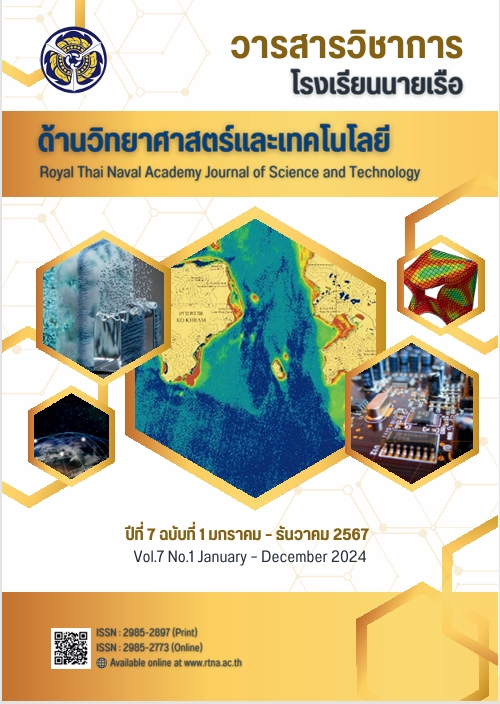Using Machine Learning (Multiple Regression Model) to Conduct Satellite Derived Bathymetry with Sentinel-2 in Sattahip Bay, Thailand.
Main Article Content
บทคัดย่อ
The aim of this study is to utilize machine learning (Multiple Regression Model) to perform Satellite Derived Bathymetry (SDB) with six image bands, namely blue, green, red, near-infrared, NDWI, and NDVI, from Sentinel-2 in Sattahip Bay, Thailand. The results demonstrated that the multiple regression model achieved higher accuracy (48.27%) compared to the ratio algorithm approach with the same areas and datasets. However, the depth values from the multiple regression model cannot meet the standard set by the International Hydrographic Organization (IHO). Nonetheless, they can serve as an initial identifying underwater objects, enhancing the safety of hydrographic surveyors, and reducing survey time.
Article Details

อนุญาตภายใต้เงื่อนไข Creative Commons Attribution-NonCommercial-NoDerivatives 4.0 International License.
เนื้อหาและข้อมูลในบทความที่ลงตีพิมพ์ในวารสารวิชาการโรงเรียนนายเรือ ด้านวิทยาศาสตร์และเทคโนโลยี ถือเป็นข้อคิดเห็นและความรับผิดชอบของผู้เขียนบทความโดยตรง ซึ่งกองบรรณาธิการวารสาร ไม่จำเป็นต้องเห็นด้วย หรือร่วมรับผิดชอบใด ๆ
บทความ ข้อมูล เนื้อหา รูปภาพ ฯลฯ ที่ได้รับการตีพิมพ์ในวารสารวิชาการโรงเรียนนายเรือ ด้านวิทยาศาสตร์และเทคโนโลยี ถือเป็นลิขสิทธิ์ของโรงเรียนนายเรือ หากบุคคลหรือหน่วยงานใดต้องการนำทั้งหมดหรือส่วนหนึ่งส่วนใดไปเผยแพร่ต่อหรือเพื่อกระทำการใด ๆ จะต้องได้รับอนุญาตเป็นลายลักษณ์อักษรจากโรงเรียนนายเรือก่อนเท่านั้น
เอกสารอ้างอิง
Stumpf RP, Holderied K, Sinclair M. Determination of water depth with high-resolution satellite imagery over variable bottom types. Limnol Oceanogr [Internet]. 2003 [cited 2024 Jan 23];48(1):547-56. Available from: https://doi.org/10.4319/lo.2003.48.1_part _2.0547
Lyzenga D. Remote sensing of bottom reflectance and water attenuation parameters in shallow water using aircraft and LANDSAT data. Int J Remote Sens [Internet]. 1981 Jan [cited 2024 Jan 27];2(1):71-82. Available from: https://www.researchgate.net/ publication/233151938
Cahalane C, Magee A, Monteys X, Casal G, Hanafin J, Harris P. A comparison of Landsat 8, RapidEye and Pleiades products for improving empirical predictions of satellite-derived bathymetry. Remote Sens Environ [Internet]. 2019 [cited 2024 Jan 30];233:111414. Available from: https://doi.org/10.1016/j.rse.2019.111414
International Hydrographic Organization. International Hydrographic Organization: Guidance to Satellite-Derived Bathymetry: B-13 Edition 1.0.0 [Internet]. Monaco: International Hydrographic Organization; 2024 [cited 2024 Feb 1]. Available from: https://iho.int/uploads/user/pubs/bathy/B_13_Ed100_032024.pdf
Bluman AG. ELEMENTARY STATISTICS: A STEP BY STEP APPROACH [Internet]. 9th ed. New York: McGraw-Hill; 2014 [cited 2024 Feb 2]. Available from:https://students.aiu.edu/submissions/profiles/resources/onlineBook/w3Q8y4_Elementary%20Statistics_%20S tep-By-Step%20Approach%209th%20ed%20(2014).pdf
Hydrographic Department of Royal Thai Navy. Thailand 1: 40000 Nautical Chart Number 115 Ao Sattahip. Bangkok: Hydrographic Department of Royal Thai Navy; 2006.
Hydrographic Department of Royal Thai Navy. Thailand Bathymetric Data: Number 115. Bangkok: Hydrographic Department of Royal Thai Navy; 2006.
International Hydrographic Organization. The IHO-IOC GEBCO Cook Book: IHO Publication B-11: IOC Manuals and Guides 63 [Internet]. Monaco: International Hydrographic Organization; 2019 [cited 2024 Feb 5]. Available from: https://www.star.nesdis.noaa.gov /socd/lsa/GEBCO_Cookbook/documents/CookBook_20191031.pdf
International Hydrographic Organization. International Hydrographic Organization: Standard for Hydrographic Surveys: S-44 Edition 6.0.0 [Internet]. Monaco: International Hydrographic Organization; 2020 [cited 2024 Feb 12]. Available from: https://repository. oceanbestpractices.org/bitstream/handle/11329/388.2/S-44_Edition_6.0.0_EN.pdf? sequence=5&isAllowed=y


